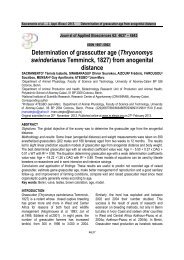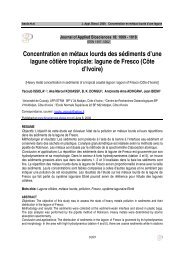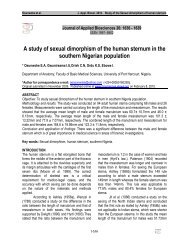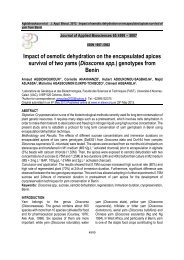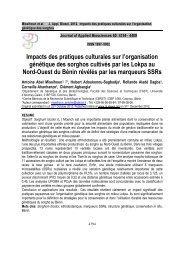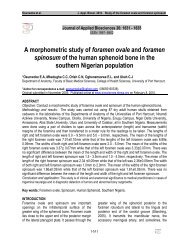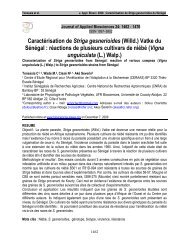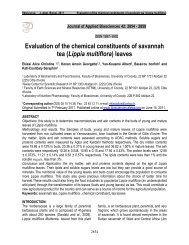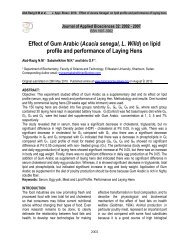Biofuels in Tanzania: Status, Opportunities and Challenges
Biofuels in Tanzania: Status, Opportunities and Challenges
Biofuels in Tanzania: Status, Opportunities and Challenges
Create successful ePaper yourself
Turn your PDF publications into a flip-book with our unique Google optimized e-Paper software.
Anthony M. Msh<strong>and</strong>ete.J. Appl. Biosci. 2011. <strong>Biofuels</strong> <strong>in</strong> <strong>Tanzania</strong>: <strong>Status</strong>, <strong>Opportunities</strong> <strong>and</strong> challengesnumerous, but only a few of them can be scientificallyverified <strong>and</strong> susta<strong>in</strong>ed. Accord<strong>in</strong>g to Foidl et al. (1996)the predictions of productivity seem to ignore theresults of plantations from the 1990s, most of which areab<strong>and</strong>oned now for reasons of lower productivity <strong>and</strong> orhigher labor costs than expected. Genetic <strong>and</strong>environmental factors have effect on oil yield productionfactors. J. curcas is still a wild species <strong>and</strong> geneticidentification of provenances <strong>and</strong> test<strong>in</strong>g them <strong>in</strong>different locations <strong>and</strong> conditions is yet to be done.There is also still a shortage of research about the<strong>in</strong>fluence of various cultivation-related factors <strong>and</strong> their<strong>in</strong>teractions <strong>and</strong> <strong>in</strong>fluence on seed yield (Parawira,2010). Therefore it is important to dist<strong>in</strong>guish betweenreality, promise <strong>and</strong> dangerous extrapolation about J.curcas as a biofuel crop whether on small-scale orlarge-scale plantation. Table 3 summarizes some of theclaims about J.curcas as an energy crop compared toresearch f<strong>in</strong>d<strong>in</strong>gs <strong>and</strong> field experiences.In <strong>Tanzania</strong> it has been reported recently that there isnot enough knowledge on <strong>in</strong>puts, outputs <strong>and</strong>management of the Jatropha plant (Messemaker,2008). Experiences demonstrate that there are lowyields <strong>and</strong> oil content beside high costs of Jatrophacultivation. To maximize return on the l<strong>and</strong> one needsto use fertilizer, irrigation <strong>and</strong> fungicide. In dry areasthis will require large-scale mechanized irrigation(Messemaker, 2008). Furthermore <strong>in</strong> <strong>Tanzania</strong>commercial production of Jatropha on marg<strong>in</strong>al l<strong>and</strong> isnot suitable, as it needs 500-6000 mm/year <strong>and</strong> fertilel<strong>and</strong> such as on coastal areas, low l<strong>and</strong> h<strong>in</strong>terl<strong>and</strong>s <strong>and</strong>western high l<strong>and</strong>s close to Lake Tanganyika (MAFSC,2006). Therefore the dry l<strong>and</strong> <strong>in</strong> centre of <strong>Tanzania</strong>cannot be recommended for Jatropha commercialproduction without irrigation (MAFSC, 2006). Upon thatrealization many agrofuel <strong>in</strong>vestors are choos<strong>in</strong>g todevelop their Jatropha plantations on well-watered,fertile l<strong>and</strong>s, <strong>and</strong> not “marg<strong>in</strong>al” l<strong>and</strong>s (Sulle & Nelson,2009a; Table 2). However, additional high-yield<strong>in</strong>ggenotypes of Jatropha should be selected for <strong>Tanzania</strong>for stable <strong>and</strong> economic biodiesel production. There isneed for proper policies <strong>and</strong> mechanisms to regulatethe sector to ensure that biofuels feedstock such asJatropha are not given too much priority at the expenseof other important values for nature, environment <strong>and</strong>society (Parawira, 2010). Of particular concern is thecompetition for l<strong>and</strong>, water <strong>and</strong> the displacement ofl<strong>and</strong> for the cultivation of food <strong>and</strong> other crops(Openshaw, 2000).Cook<strong>in</strong>g oil wastes from restaurants <strong>and</strong> householdscan be used as alternatives <strong>in</strong> production of high qualitybiodiesel (Nakpong & Wootthikanokkhan, 2009). Theprice of waste cook<strong>in</strong>g oil is 2.5-3.5 times cheaper thanvirg<strong>in</strong> vegetable oils, thus can significantly reduce thetotal production cost of biodiesel. Biodiesel obta<strong>in</strong>edfrom waste cook<strong>in</strong>g vegetable oils has been considereda promis<strong>in</strong>g option. Waste cook<strong>in</strong>g oil is available atrelatively cheap prices for biodiesel production <strong>in</strong>comparison with fresh vegetable oil costs (Demirbas,2009). Furthermore, lipid (fat) production from algaeholds much promise for the biodiesel <strong>in</strong>dustry s<strong>in</strong>ce itmakes up to 50 percent oil by weight <strong>and</strong> double theirnumbers <strong>in</strong> a s<strong>in</strong>gle day. Microalgae are microscopicaquatic plants that carry out the same process <strong>and</strong>mechanism of photosynthesis as higher plants but donot require fresh water or arable l<strong>and</strong> used forcultivation of food crops (Weber, 2009). Agriculture <strong>and</strong>forest residues provide a large potential as alternativefeedstock, especially if the second-generation biofueltechnology is applied to exp<strong>and</strong> on the potential forestresidues. Assum<strong>in</strong>g that 4 tons of waste can produce 1ton of ethanol, this may have better susta<strong>in</strong>ability <strong>in</strong>terms of contribution to green house gases emissionreduction <strong>and</strong> food security (Li & Chan-Halbrendt,2009).2684



